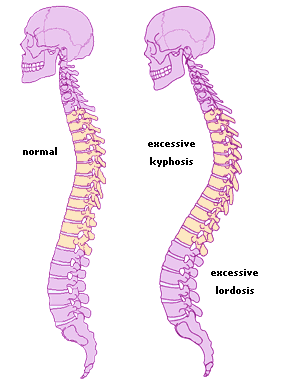
Overview
Spinal Lordosis, more commonly known as swayback, is when there is an excessive inward curvature of the spine most often between the L1-L5 vertebrae. This leads to excessive pressure on the spine causing discomfort and pain. Many people with this condition also experience shots of electric pain, numbness, and tingling.
Causes
-Many causes of any form of scoliosis happen during adolescence, often fixing itself as the child grows, if it continues it can be treated quickly if spotted as you are still growing.
-Pregnancy: Many women during pregnancy will start to develop lordosis as the spine tries to re-align to the center of gravity.
-Spondylolisthesis: Spinal condition in which one of the lower vertebra slips forward onto the bone below.
-Achondroplasia: Common type of dwarfism.
-Osteoporosis: Disease that causes a loss of bone density.
-Osteosarcoma: Bone cancer that develops in the shinbone, thighbone, or upper arm bone.
-Obesity: This condition always puts people at a higher risk for serious diseases.
Treatments
-Of course people will often take medications to reduce swelling
-Physical therapy can help to strengthen muscles and range of motion
-Braces, these will only work if the person diagnosed is still growing, used for adolescence.
-Vitamin D can help to strengthen bones depending on clause
-In worst case scenarios surgery is recommended
Outcomes
Luckily a lot of cases will get better on their own over time, Some people can go their whole lives with just the use of medication to ease the minimal pain caused. Especially with age though, many will reconsider the possibilities of surgery. Even though thousands of surgeries have been done to fix Spinal Lordosis we still have a high risk of paralysis going into the surgery.
Risks of Paralysis
Working with the spine is already a touchy subject (literally). You are working around multiple different nerves, stripping muscles, and exposing a lot of area close to many of the organs within the abdominal cavity. With the high risk of Paraplegia (loss of movement in legs) the spinal cord is thoroughly monitored throughout the surgery to make sure the nerves are still sending signals. Unlike the commonly known scoliosis which has a high success rate with only 2-3% chance of complications, Lordosis surgery has 70-75% chance of complications leaving only a 25-30% chance of success rate.
Additional Risks
-Flat-back syndrome: Loss (or flattening) of the natural lordosis curve in the low back and may become a cause of lower back pain
-Crankshaft phenomenon: Deformity when the front of the spine keeps growing while the back of the spine does not.
-Adding-on phenomenon: Adolescence has a thoracic curve fused, but the curve continues to progress (add on) beneath the fusion level.
Story time
A very close friend of mine has grown up with Spinal Lordosis. He knew he was in pain but never told his mom because he knew the money for even a doctor’s visit would cost. By the time that he found out what had been causing the pain in his back the whole time he was already 19 years old. Being told the risks of the surgery with a very low probability of a successful outcome due to the severity of a condition is scary. He uses CBD treatments and heat pads daily to cope with pain. Knowing that it will get worse as they get older means wanting to live now, the risk of paralysis is terrifying especially for someone so young. We are still advancing in the medical field and the probability of success still continues to grow for this surgery but will it ever be enough for people with the same conditions and the same fears. There are more than 200,000 cases per year diagnosed but still a low success. I would risk being in pain too if it meant still being able to go out and longboard or do normal jobs like everyone else.
Advances over years
-ability to closely monitor nerves during process
-Understanding that the fusion process in children should not be taken as they are still growing and it can worsen the spine.

Lordosis is known as an inward curve of the spine. Some people call this a “swayback.” Lordosis can occur in the lower back, and this is also known as the lumbar lordosis. This happens in the neck; the correct medical name for it is cervical lordosis. The spine can curve outward, into a hump shape, also known as kyphosis. This affects the middle or upper back than the lower back or neck. Lordosis can cause a person to lose control of their bladder or bowels. They can also experience sudden, severe leg pain, or weakness. A doctor typically identifies lordosis through a physical examination. They can also order an X-ray, MRI, or CT scan to confirm the diagnosis. Usually, a scan can indicate the extent of the curve in the spine. Typically the symptoms of an old or new injury along with a medical condition could cause lordosis. At this point, a doctor would have to perform additional tests to diagnose. This is caused by damage to the spine, and this could have happened with a past fracture. Osteoporosis weakens our bones; this could increase the risk of these fractures. If one with severe lordosis required surgery, a surgeon would attach metal rods to the bones in the spine, and this is permanently fused into a straighter position. Physical therapy will be required where you would need to see a physical therapist or trainer who specializes in these types of conditions. You can do at-home workouts to help with pain and stretches such as hip flexor stretches, Cat cow pose, and supine hollowing. One with mild lordosis may not need treatment. The benefit from physical therapy or over-the-counter medication could help the pain. If you have severe lordosis, this could require surgery, unfortunately.